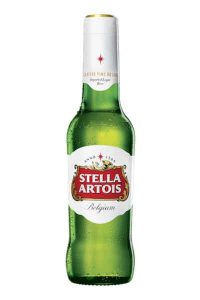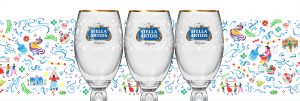53 Stella Artois
Introduction
A bottle of Stella Artois contains not only a delicious alcoholic beverage, it also holds a significant history. Stella traces back all the way to 1366 a.d. in the city of Leuvan, Belgium (From Belgium With Love, 2016) and has stood the test of time. It survived wars, cultural changes, and evolution itself. It’s come a long way from a simple brewing technique in Belgium to the product that fills the fridges and beer stores in North America today.

A modern Stella Artois bottle
Origins
Back in 1366 in the Den Hoorn brewery opened. Less than 350 years later (1708), Sebastien Artois became its head brewmaster and then 9 years later (1717) he purchased the brewery himself. He renamed it Brouwerij Artois. (Wikipedia, Stella Artois, n.d.)

Old brewing equipment from the Den Hoorn brewery
Key Milestones
Perhaps one of the more significant milestones for this beer happened in 1926 when the brewery gifted a special “Christmas Brew” exclusively for the city of Leuvan residents. This is where the name ‘Stella’ comes from as Stella means star in Latin. (From Belgium With Love, 2016) Originally, Stella only sold in the winter months. By 1930, it became available all year round and began exporting into other European markets. (Wikipedia, Stella Artois, n.d.)
https://prettybird.co/us/work/brand-content/stella-artois-be-legacy-the-history-of-sebastian-artois/
Video representing when Sebastien Artois purchased the Den Hoorn brewery.
Brewing Science and Industrialization
The industrial revolution not only made the brewing process faster and more streamlined, it also allowed their product to go out faster and further. The small brewery in Leuven, Belgium ballooned in size and output of their beer. Less people were needed to make the product, and so profits increased and led to bigger breweries with more and better equipment. Eventually the product was able to cross into other countries and eventually continents. The invention of the steam engine revolutionized the brewing process. Stella could be made on a larger scale, with less physical effort. The revolution also meant it could be shipped out via train or boat. With new scientific discoveries about the brewing process itself, the science of beer became more of an exact science instead of a recipe handed down through generations. These scientific discoveries and the industrial revolution itself lead to a shift in where people employed in the breweries held jobs: there were heavy concentrations of employees working in labs rather than on the warehouse floor.
Beer Style
Stella Artois is a pilsner, which is a type of pale lager. Pilsner was an evolution in beer. In the city of Pilsen, Czechoslovakia a brewery began taking the top fermented style of beer and changing it. Back in the 1800’s brewers began aging beer with cool fermenting yeasts in caves to improve clarity and shelf life. (Wikipedia – Pilsner n.d) This changed eventually to using barrels in cellars. This process didn’t change again until the 1990’s when large tanks were used instead. New techniques were added and eventually pilsner because lighter, or ‘paler’. At the same time the revolution made glass prices cheaper, showcasing the paleness of the product. Communication and transportation improved so that the process was picked up by other breweries including the Brouwerij Artois brewery. The pilsner taste is unique in that it is lighter, made with more hops than your typical lager, making it so it doesn’t exactly taste like the traditional beer that comes to mind with the average consumer.
The WWI and WWII Era
Although the Leuven brewery continued to operate during WWI, the actual Stella that we know today wasn’t actually introduced until the war was over. The Germans invaded Belgium in 1914 which caused Great Britain to become involved. This led to a shortage of beer in Belgium and a decline in its quality. A large number of breweries closed. An increase in the cost of materials and therefore in the price of beer itself, lead to a decrease in consumers. Through all of this, the Brouwerij Artois brewery survived. In 1926, after the war, Stella was introduced first as a special Christmas brew dedicated to the members of the town of Leuven. (Wikipedia, Stella Artois, n.d.) The brew was so popular it was then sold year-round. After WWI Belgium returned to its neutral state with no aspirations of war. Unfortunately, in 1941, WWII began resulting in the temporary shutdown of the Brouwerij Artois brewery. This was because Belgium was once again raided by the Germans, forcing them to go back to war to fight for their freedom. (Wikipedia, Belgium in World War II, n.d.)
Consolidation and Globalization
In 1988, the Brouwerij Artois brewery merged with Walloon-based brewer Piedboeuf and created Interbrew. It acquired the notable Canadian brand Labatt. Labatt was only slightly smaller than Interbrew at the time and had many assets including the Toronto Blue Jays, the Toronto Argonauts and The Sports Network (TSN). Rather than making it all into one company that identified as the Belgium Interbrew, It celebrated its multinationalism and its Canadian and Belgium roots.In 2004, Interbrew merged again, this time with a Brazilian brewer Ambev. The renamed partnership was now called Inbev. This merger was extremely profitable and it produced beers like Stella Artois, Budweiser and Corona. In 2008 Inbev bought Anheuser-Busch which owned major brands like Michelob and Rolling Rock This created the world’s largest brewing company and completely smashed the competition (SABmiller) which they eventually bought in 2016. Although Stella Artois might fly under the radar as one of the worlds biggest beer brands, it is really the foundation of the largest brewing company in the world.
Marketing and Branding
Back in 1988, Interbrew created a new package, bottle design and shape. It was inspired by the original 1926 bottle design. Stella was marketed wisely and its name often thought to be french. Marketing executives tried to push the idea that Stella Artois was a premium product that should be experienced by the true beer lover. Evidence of this can be seen by the ‘9 step pouring ritual’ which includes the purification, the sacrifice, the liquid alchemy, the crown, the removal, the skimming, the judgement, the cleansing and the bestowal. This is all part of the Stella draught pouring technique that was developed for their special challis glasses.
The 9 step pouring ritual
Stella Artois has partnered with many big celebrities for advertising campaigns, this includes Sarah Jessica Parker, Jeff Bridges and Matt Damon. Not only were these celebrities impressive but the commercials took place in high profile spots such as during the Superbowl TV broadcast. To marketing and advertising gurus, this is the elite of the elite spots for an advertisement.
Sarah Jessica Parker and Jeff Bridges work together to create super bowl commercial for Stella Artois.
The Modern Era
In the modern era, Stella Artois is currently in the ‘mature’ phase and the next phase would be decline. Stella has gone to great lengths to prevent a rapid decline. From multiple marketing techniques such as the 9 step pour and funny commercials with well known celebrities to their humanitarian initiative partnership with Water.org, founded by Matt Damon and Gary White which has already changed tens of millions of people’s lives for the better. This partnership is called the ‘Pour It Forward’ which is a very good marketing slogan.
Matt Damon on Water.org’s partnership with Stella Artois
For every limited edition Stella Artois chalice purchased in 2019, $3.13 is donated to supply water for people in developing countries across the world who do not have access to clean water. The $3.13 is an average amount that Stella and Water.org came up with to be able to supply water for one person for up to 5 years. (Water.org, 2019)

Limited edition Stella Artois Chalices, available for purchase at https://water.org/stellaartois/
Like many products trying to avoid dropping sales, in 2018 Stella Artois ‘went back to its roots’ releasing L’Heritage Artois, a limited edition beer specifically sold during the Christmas season. It was sold in fancy and larger bottles (at fancy and larger prices) with an increased alcohol content of 6.5 percent ABV. (Vinepair.com, March 2019)
In 2019, Stella jumped on the hard-cider and spritzer bandwagon and released its very own hard cider and spritzers in order to compete with numerous other companies doing the same thing. Trends show a rise in incorporating wine products into ciders and spritzers. The new Stella products embraced this and used it to ‘class up’ the old look of their product. (Beverage Daily, Beth Newhart, 2019)
Stella Artois is adamantly trying to avoid entering the state of decline in sales of their product. By using the fresh faces of well known celebrities who are dedicated to using their platform to better the world, Stella Artois is attempting to re-imprint their brand as a product that cares. Jumping on this generation’s focus on environmental and humanitarian causes shows they are modern and worthy of consumption with a new era of beer enthusiasts.
References
https://www.stellaartois.com/en_ca/our-brand/heritage.html
https://en.wikipedia.org/wiki/Stella_Artois
https://en.wikipedia.org/wiki/InBev
https://www.thespruceeats.com/pilsner-beer-history-profile-and-ingredients-353311
https://en.wikipedia.org/wiki/Belgium_in_World_War_II
https://www.beveragedaily.com/Article/2019/03/04/Spritzer-is-Stella-s-first-US-innovation-since-2013
https://vinepair.com/articles/stella-artois/
https://water.org/stellaartois/

